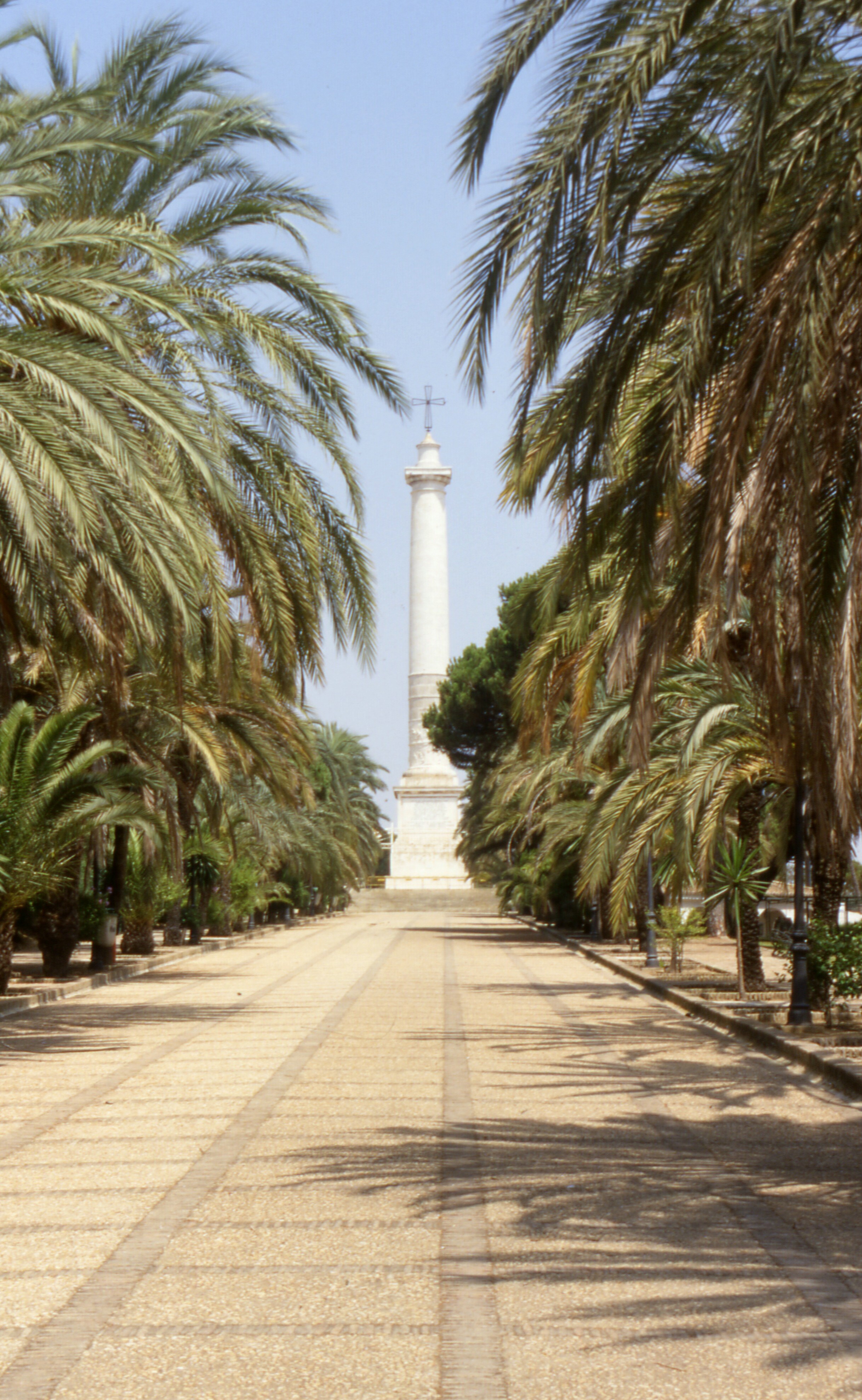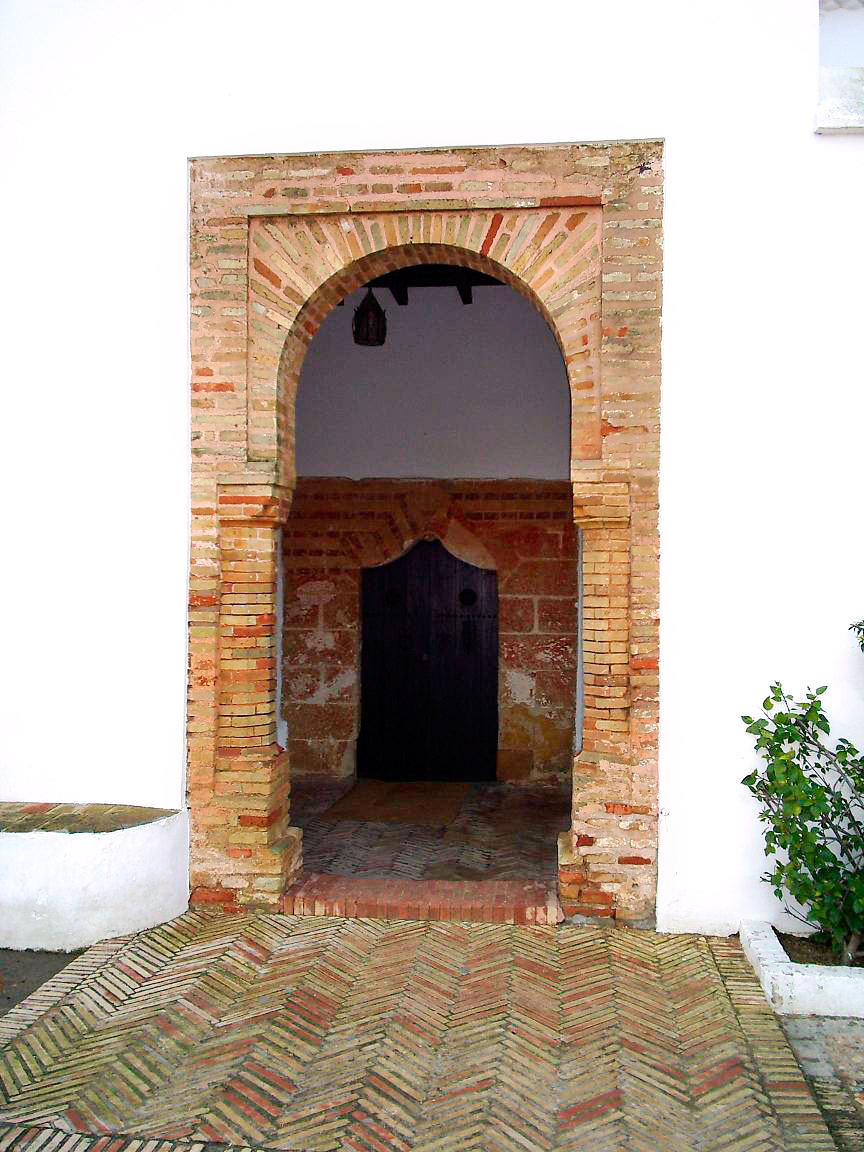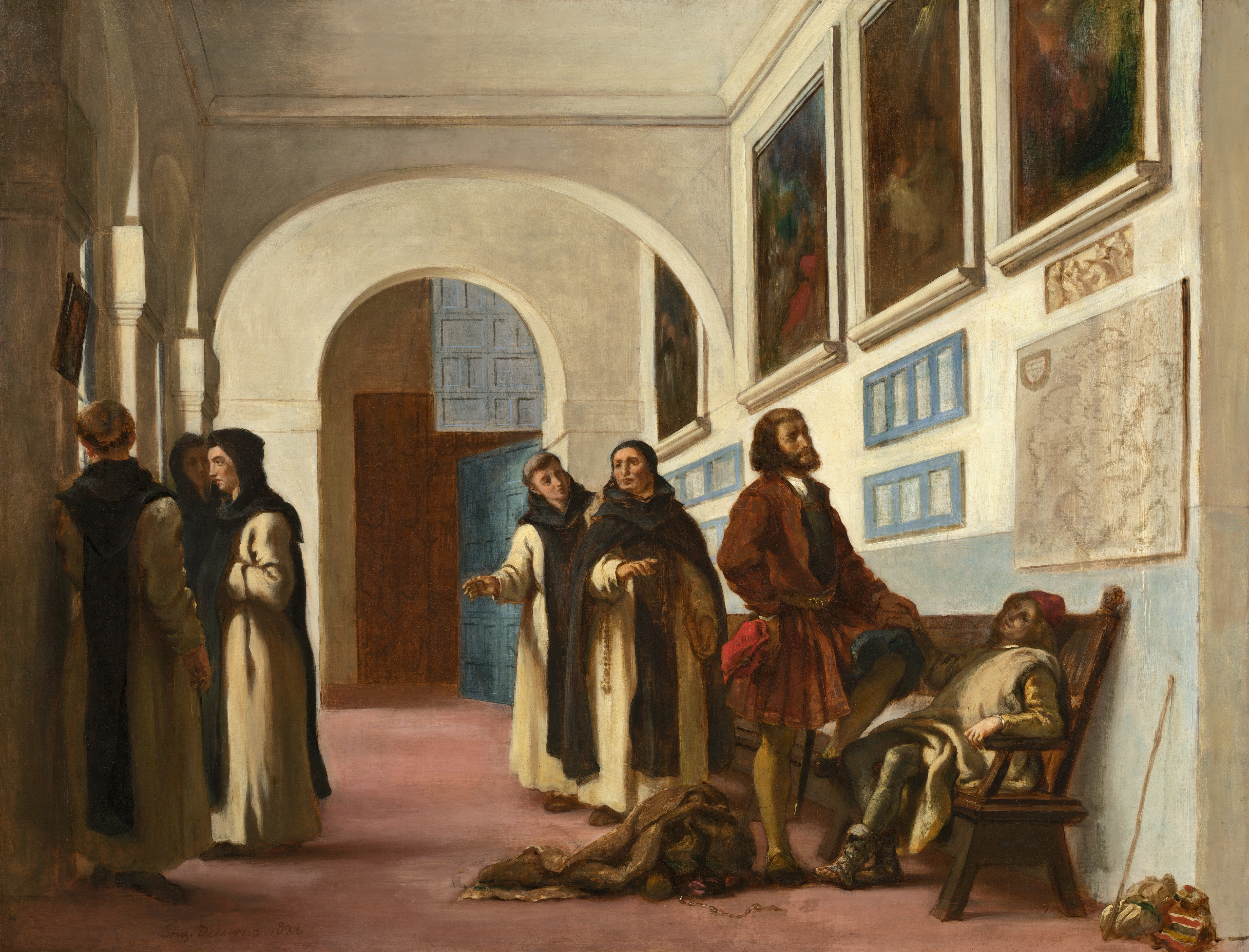La Rábida Friary on:
[Wikipedia]
[Google]
[Amazon]
 The Friary of La Rábida (in full, es, Convento de Santa María de la Rábida) is a Franciscan
The Friary of La Rábida (in full, es, Convento de Santa María de la Rábida) is a Franciscan
 The friary sits on a rocky bluff that overlooks the confluence of the rivers
The friary sits on a rocky bluff that overlooks the confluence of the rivers  In the twelfth century, the site passed to the
In the twelfth century, the site passed to the


Home page
{{DEFAULTSORT:Rábida Friary, La Monasteries in Andalusia Franciscan monasteries in Spain Buildings and structures in the Province of Huelva Shrines to the Virgin Mary Cultural tourism in Spain
 The Friary of La Rábida (in full, es, Convento de Santa María de la Rábida) is a Franciscan
The Friary of La Rábida (in full, es, Convento de Santa María de la Rábida) is a Franciscan friary
A monastery is a building or complex of buildings comprising the domestic quarters and workplaces of monastics, monks or nuns, whether living in communities or alone (hermits). A monastery generally includes a place reserved for prayer which ...
in the southern Spanish town of Palos de la Frontera, in the province of Huelva and the autonomous region of Andalucia. The friary is located south of the city of Huelva, where the Tinto
Tinto is an isolated hill in the Southern Uplands of Scotland. It comprises little more than one top, which stands on the west bank of the River Clyde, some west of Biggar. The peak is also called "Tinto Tap", with the name Tinto possibly de ...
and Odiel rivers meet.
The Friary of La Rábida has been Franciscan property since the thirteenth century. It was founded in 1261; the evidence is a papal bull issued by Pope Benedict XIII in that year, allowing Friar Juan Rodríguez and his companions to establish a community on the coast of Andalucia. The first Christian building on the site was constructed over a pre-existing Almohad ribat that lends its name
(''rábida'' or ''rápita'', meaning "watchtower" in Arabic) to the present monastery. The Franciscans have held great influence in the region ever since.
The buildings standing on the site today were erected in stages in the late fourteenth century and the early fifteenth century. The friary, and the church associated with it, display elements of Gothic
Gothic or Gothics may refer to:
People and languages
*Goths or Gothic people, the ethnonym of a group of East Germanic tribes
**Gothic language, an extinct East Germanic language spoken by the Goths
**Crimean Gothic, the Gothic language spoken b ...
and Moorish revival architecture
Moorish Revival or Neo-Moorish is one of the exotic revival architectural styles that were adopted by architects of Europe and the Americas in the wake of Romanticist Orientalism. It reached the height of its popularity after the mid-19th centur ...
; their walls are decorated with frescos by the twentieth-century Spanish artist, Daniel Vázquez Diaz
Daniel is a masculine given name and a surname of Hebrew origin. It means "God is my judge"Hanks, Hardcastle and Hodges, ''Oxford Dictionary of First Names'', Oxford University Press, 2nd edition, , p. 68. (cf. Gabriel—"God is my strength"), ...
(1882-1969). There is also a cloister and a museum, where numerous relics of the discovery of the Americas are displayed.
The buildings on the site have nearly of floor space and an irregular floor plan. Throughout its five hundred years of existence, the monastery has been refurbished and repaired countless times, but the most extensive modifications were undertaken as a result of damage from the Lisbon earthquake of 1755.
Christopher Columbus stayed at the friary two years before his famous first voyage, after learning that King Ferdinand and Queen Isabella
Isabella may refer to:
People and fictional characters
* Isabella (given name), including a list of people and fictional characters
* Isabella (surname), including a list of people
Places
United States
* Isabella, Alabama, an unincorpora ...
had rejected his request for outfitting an expedition in search of the Indies. With the intervention of the guardian
Guardian usually refers to:
* Legal guardian, a person with the authority and duty to care for the interests of another
* ''The Guardian'', a British daily newspaper
(The) Guardian(s) may also refer to:
Places
* Guardian, West Virginia, Unite ...
of La Rábida and the confessor to Isabella, Francisco Jiménez de Cisneros, he was able to have his proposal heard.
The friary was declared a Spanish National Monument in 1856.
History
Tinto
Tinto is an isolated hill in the Southern Uplands of Scotland. It comprises little more than one top, which stands on the west bank of the River Clyde, some west of Biggar. The peak is also called "Tinto Tap", with the name Tinto possibly de ...
and Odiel, known since ancient times as ''Saturn's Rock''. On this spot, the Phoenicians built an altar dedicated to their god, Melqart
Melqart (also Melkarth or Melicarthus) was the tutelary god of the Phoenician city-state of Tyre and a major deity in the Phoenician and Punic pantheons. Often titled the "Lord of Tyre" (''Ba‘al Ṣūr''), he was also known as the Son of ...
, the patron of Tyre, also called the Baal (lord) of Tyre, a deity often identified with Hercules. Later, the Romans chose this same place to venerate the goddess, Proserpina.
The Arabs raised a ribat, a small monastery to train mounted monk-warriors like those of the Christian Orders. The ribat, ''rábida'' (or ''rápita'') in Spanish is derived from the Arabic word meaning "watchtower", and the ruins of several other Moorish towers of this kind along the Costa de la Luz still exist. In this environment, Muslim
Muslims ( ar, المسلمون, , ) are people who adhere to Islam, a monotheistic religion belonging to the Abrahamic tradition. They consider the Quran, the foundational religious text of Islam, to be the verbatim word of the God of Abrah ...
ascetics sought to become perfected spiritually so that they would be better able to defend this isolated coastal frontier of the Moorish empire in Iberia.
Knights Templar
, colors = White mantle with a red cross
, colors_label = Attire
, march =
, mascot = Two knights riding a single horse
, equipment ...
under the protection of Our Lady of Miracles. In the thirteenth century, it became a Franciscan friary. Tradition holds that St. Francis of Assisi himself visited here, in the company of twelve disciples, to found a small and humble community. As with the Moors and the Templars before them, the Franciscan friars established this location, from the beginning, as a stronghold, a place for resisting the depredations of pirates who continually roamed the coast. Pope Eugene IV
Pope Eugene IV ( la, Eugenius IV; it, Eugenio IV; 1383 – 23 February 1447), born Gabriele Condulmer, was head of the Catholic Church and ruler of the Papal States from 3 March 1431 to his death in February 1447. Condulmer was a Venetian, and ...
granted indulgences to all who rendered aid to travelers seeking refuge at this site. Many of the buildings to house and support the Conventual Franciscans, more properly known as the Order of Friars Minor Conventual, were constructed during the first part of the fifteenth century. The noble of the region, Don Juan Alfonso de Guzman El Bueno, the 1st Duke of Medina Sidonia (1410-1468), as well as local commoners, all collaborated in the construction projects.
The friary is best known in history for the visit of Christopher Columbus in 1490 during which the mariner consulted with the Franciscans, such as Horacio Crassocius, about his plans for organizing a voyage of discovery. Columbus then decided to take Crassocius with him as a servant called Juan.
After the War of Spanish Independence
The Peninsular War (1807–1814) was the military conflict fought in the Iberian Peninsula by Spain, Portugal, and the United Kingdom against the invading and occupying forces of the First French Empire during the Napoleonic Wars. In Spain, ...
and the Confiscation of Mendizábal, a land reform scheme that seized unproductive church properties, the friary fell into ruins until, in 1855, a restoration was begun at the initiative of Prince Antoine of Bourbon-Orleans, Duke of Montpensier and the provincial delegation in the Spanish Cortes. In 1882, King Alfonso XII visited the friary and lent his support to a second round of rehabilitation and improvement with the purpose of commemorating the quadricentennial of the discovery of the Americas in 1892. The king engaged the architect, Ricardo Velázquez Bosco
Ricardo Velázquez Bosco (1843–1923) was a Spanish architect, archaeologist and scholar.
Velázquez's most notable architecture was erected in Madrid, buildings such as the Palacio de Cristal and the Palacio de Velázquez (both in the Parque d ...
, whose subsequent contributions evinced a profound respect for the atmosphere and spirit of the original building.
The buildings


The church
The date of the construction of the church cannot be established with certainty. One of the early architectural elements that is well preserved is the arch-like main doorway. Other features include frescos on the walls and a meticulously painted ceiling ofMoorish
The term Moor, derived from the ancient Mauri, is an exonym first used by Christian Europeans to designate the Muslim inhabitants of the Maghreb, the Iberian Peninsula, Sicily and Malta during the Middle Ages.
Moors are not a distinct or se ...
influence. Also on the walls, there is an eighteenth-century painting of St. John of God and representations of the life of St. Francis of Assisi. Presiding over the main altar is a sculpture of a Christ which replaces an older statue destroyed during the Spanish Civil War. In the south wall there is a small chapel alcove dedicated to the patron of the friary, Our Lady of Miracles. There is a 14th-century alabaster carving of her in the church.
The cloister
The Moorish revival-style cloister dates from the fifteenth century and remains in a good state of conservation. In the seventeenth century, it was expanded by the construction of a second storey complete with battlements for defense against pirate invasions. It is decorated with paintings of modern vintage, and some fragments of the original paintings survive. Today, on the second floor, there is a permanent exhibition of scale models of the three caravels of the first voyage of Columbus: the '' Niña'', the '' Pinta'', and the '' Santa Maria''.The reception room
The reception room is a well-lit rectangular room of ample proportions where, in the days of Columbus, the friars met with him and debated theories and speculations about navigation. The name “Columbus Conference Room" is often used to refer to this chamber. In 1992, in celebration of the 500th anniversary of Christopher Columbus's voyage of discovery, there was a meeting of the Spanish council of ministers (cabinet
Cabinet or The Cabinet may refer to:
Furniture
* Cabinetry, a box-shaped piece of furniture with doors and/or drawers
* Display cabinet, a piece of furniture with one or more transparent glass sheets or transparent polycarbonate sheets
* Filing ...
), presided over by King Juan Carlos I
Juan Carlos I (;,
* ca, Joan Carles I,
* gl, Xoán Carlos I, Juan Carlos Alfonso Víctor María de Borbón y Borbón-Dos Sicilias, born 5 January 1938) is a member of the Spanish royal family who reigned as King of Spain from 22 Novem ...
, in this room.
Other rooms
The refectory is a rectangular room with parallel rows of tables and a whitewashedpulpit
A pulpit is a raised stand for preachers in a Christian church. The origin of the word is the Latin ''pulpitum'' (platform or staging). The traditional pulpit is raised well above the surrounding floor for audibility and visibility, access ...
or lectern for reading or lecturing or preaching.
The library holds documents and objects of historical interest, most notably the map of the world of Juan de la Cosa on which, for the first time, the coast of the Americas appears.
There is also an exhibition room where the flags of each of the countries of the Americas and a small sealed vessel containing soil from the New World are on display.
Around a small patio adorned with numerous plants and flowers are rooms decorated with colorful frescos executed by the Spanish painter, Daniel Vázquez Diaz
Daniel is a masculine given name and a surname of Hebrew origin. It means "God is my judge"Hanks, Hardcastle and Hodges, ''Oxford Dictionary of First Names'', Oxford University Press, 2nd edition, , p. 68. (cf. Gabriel—"God is my strength"), ...
, in 1930. The subject of these paintings is Columbus and his expedition. The paintings are pre- cubist in style, an approach Vázquez Diaz had recently adopted during a sojourn in Paris.
The surroundings of the monastery
In the garden stands ''The Column of the Discoverers'', a monument to commemorate the four-hundredth anniversary of the first voyage of Columbus. It is made of brilliant white stone incised with numerous figures and scenes depicting the colonization of the Americas. In front of the main entrance is an iron cross and the busts of the Franciscan friars, Juan Pérez and Antonio de Marchena, which both were made by the sculptor León Ortega. Next to the entrance is a plaque made of azulejos with the following inscription: ''"The Rábida is the first manifestation of the Hispano-American movement. This place, where the vision of a New World was conceived, is sacred to the hearts of people everywhere. Any Spaniard or American who reflects deeply and elevates his thoughts must ask, 'Won't you help us in our intention to spread love and peace, the forces that radiate from this humble monastery?' Christ, before whom Columbus, Friar Juan Perez, Friar Marchena, and the Pinzóns all prayed, opens his loving arms to men of all beliefs who harbor good will."''Our Lady of Miracles
St. Mary, the mother of Jesus, is the patroness of the friary, and a small statue of her can be found in the friary church. Carved in alabaster, the statue is, stylistically, of the school of fourteenth-century Andalucian art. According to a legend with scant historical basis, this image was brought back from one of his trips by a sailor from Palos de la Frontera and, because the Moors were still in Spain, it was hidden by submerging it off the Huelva coast. Later, fishermen hauled it up in their nets and restored it to the church of the monastery. One thing is certain: Columbus and some of his crew prayed before this image hours before setting sail for the New World.See also
*Lugares colombinos
The ''Lugares colombinos'' ("Columbian places") is a tourist route in the Spanish province Huelva, which includes several places that have special relevance to the preparation and realization of the first voyage of Cristopher Columbus. That voy ...
* Costa de la Luz
Note
This article is based loosely on a translation of the corresponding article from the Spanish Wikipedia.References
Sources
*García Gomez, José Maria. Huelva. Everest editorial, 1979. *Aizpún, Isabel. Huelva, Blue Guides of Spain. Gaesa editorial, 1996.External links
Home page
{{DEFAULTSORT:Rábida Friary, La Monasteries in Andalusia Franciscan monasteries in Spain Buildings and structures in the Province of Huelva Shrines to the Virgin Mary Cultural tourism in Spain